With living expenses on the rise, more homeowners are looking to cut costs. Renewable energy is quickly growing within the homeowners market, as it’s eco-friendly and can save you some money when it comes to the electric bill.
That is why we’ve put the best home and residential wind turbines for homes to the test to help you in your search for the best option for your home.
Generating your own electricity is an easy way of cutting your electric bill in half (that’s a dream come true for many of us). While solar energy is generally the go-to eco-friendly option, wind power is a great solution for those living in areas with reliable wind speeds.
Whether you’re living in a rural area and don’t have access to an electric grid, or are living in a suburb and looking to reduce your utility bill, home wind turbines are a great solution. All that’s required is a little know-how, some land, and a high voltage battery bank.
For an initial investment of around USD $800, you can buy yourself a mid-range home wind turbine that can comfortably meet your needs.
Our Top Picks
| Product | Details | ||
|---|---|---|---|
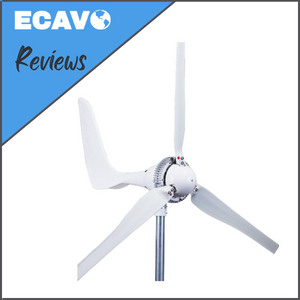 |
Best Overall: WINDMILL 1500W Wind Turbine Generator Kit | This wind turbine is our top choice for several reasons but is mainly due to its high-quality build. This makes for a great investment that will last for years. | Check Price |
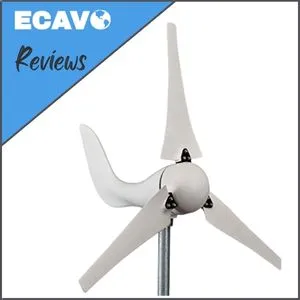 |
Best Budget Pick: Windmill (DB-400) 400W 12V Wind Turbine Generator kit | This option is our best overall little brother, meaning that it brings all the perks from the 1500W, but it generates less power, making it perfect for sheds and cabins where fewer appliances are needed. | Check Price |
 |
Best Mid-Range Option: PIKASOLA 1000W | This is another good quality wind turbine at a great price, easy to install, and comes with a lot of information on how to make the best out of it for new users. | Check Price |
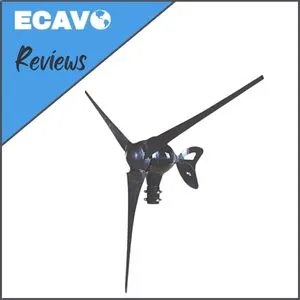 |
Best Home Wind Turbine for Wet Areas: 2000-Watt Marine Wind Turbine Power Generator | This wind turbine’s best feature is that it’s best used in wet areas, such as the beach, where corrosion would destroy other wind turbine options. | Check Price |
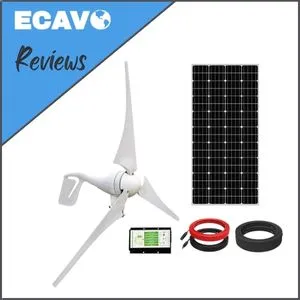 |
Best Home Wind Turbine and Solar Panel Kit: ECO-WORTHY 600W Solar Wind Power Kit | This is the best wind and solar system for those looking to transition from carbon-based energy to alternative energy to power their households. | Check Price |
What is a Wind Turbine?
In this article, we’ll be talking about home, or domestic, wind turbines. In essence, these wind turbines use the motion of the wind against the blades (kinetic energy) and translate that into electric energy to feed your household’s electrical needs.
Keep in mind that the amount of energy generated by the wind turbines will depend on the position in which your turbine is set as well as on the wind you get at your home.
If you want to use your home wind turbine for net metering, make sure you check with your local utility provider to see if they have specifications and regulations in place before you make your purchase.
For more on how to know if a domestic wind turbine is right for you, we touch on several topics in our Complete Home Wind Turbines Buyer’s Guide later in this article.
How We Ranked The Best Wind Turbines For Home
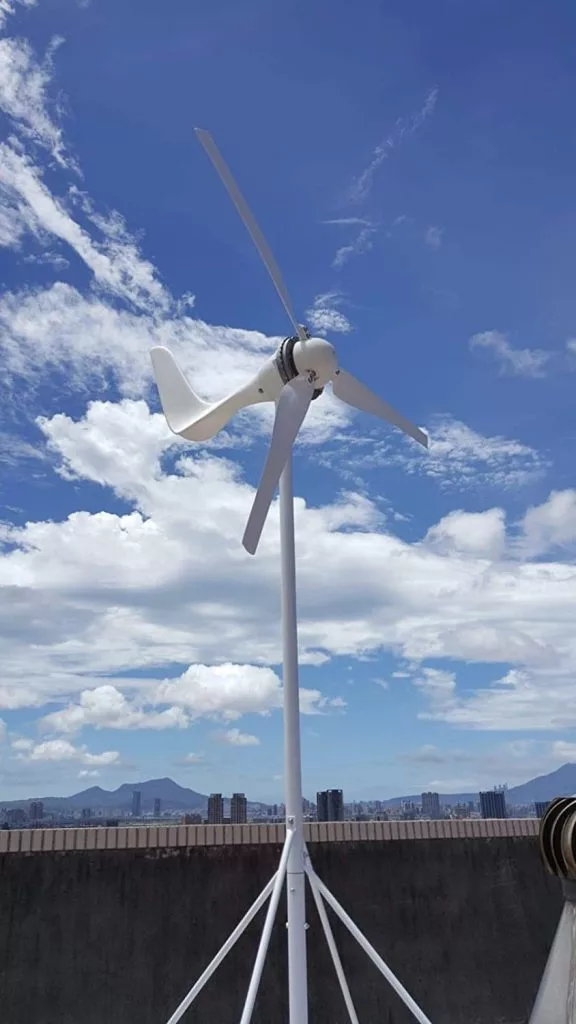
Based on a range of factors, including the number of blades, weight, wind speed rating, energy output, and features, we’ve selected the 5 best wind turbines for homes currently on the market.
Our rankings place an emphasis on utility, efficiency, and reliability, while also taking into consideration price and real-world experience. As a residential green-energy source, these wind turbines must also have a minimum amount of power.
Blades
The amount and size of the blades will affect the overall efficiency and usefulness of the wind turbine. Those with fewer blades will cause the rotor to spin more quickly, generating more energy at faster speeds, while those with more blades will pick up low wind speeds and can operate without the need for consistently heavy wind.
The length of the blade is an important consideration, as well. If the blade is long, then the turbine will need a larger buffer zone. Those with small or compact blades are better suited for urban areas where space is more of an issue.
Wind Speed Rating
The wind speed rating is the average amount of wind needed for the turbine to operate at peak efficiency. While the turbine will still generate electricity at speeds below the rating, it won’t be able to meet its listed wattage unless it’s receiving the wind speed rating or higher.
In general, those with lower wind speed ratings are ranked higher because they offer the most flexibility for homeowners.
Weight
While the combined weight of the kit isn’t the most important consideration, it still affects placement. If the kit is heavy, then it will need an expensive and sturdy pole to support it. It also shouldn’t be placed on roofs or around other structures that may be damaged. Ultimately, the lighter the unit, the better.
Energy Output
In general, the energy output of the generator is the most important factor for most buyers. After all, the whole purpose of a wind turbine is to convert wind energy to electricity. Any model that has a wattage below 500W is effectively useless unless you plan on using it to power a string of outdoor lights or charge a phone.
The average wattage for a reasonably priced home wind turbine is around 1000W. This is a great starting point for first-time buyers.
Features
Wind turbines are simple machines and generally don’t come equipped with many bells and whistles. However, according to our experience, there are several features that make one turbine stand out from the crowd.
As with most things, the more features a home wind turbine offers, the better value for money. This is especially true for those with integrated load dumps and MPPT charge controllers.
Here are the most common and useful features on offer:
- Automatic braking systems
- Charge controllers
- Low-wind efficiency
- Protective coating (marine, anti-UV, anti-corrosion)
Best Residential Wind Turbines (For your home)
1. Best Overall: WINDMILL 1500W Wind Turbine Generator Kit
Product Ratings
| Reliability: | 5/5 |
| Sturdiness: | 5/5 |
| Quality vs Price: | 5/5 |
Blades: 3 | Wind Speed Rating: 31 mph | Minimum Wind Speed: 5.6 mph | Volts: 24V | Weight: 33 pounds | Dimensions: 40 x 67 x 67 inches | Charge Controller Included: Yes
What We Liked
- Equipped with a high voltage capacity and energy output
- Sturdy and durable casing
- The 3-blade turbine are high-quality glass fiber with UV protection coating
- One-year warranty
- Low noise output
- Can combine the wind turbine with a solar panel
What We Didn’t Like
- It’s one of the most expensive home wind turbines on the market.
- It’s tricky to find a charge controller in case it breaks. If you don’t find one, you would need to buy the whole wind turbine again
- You need to consider other materials to put your wind turbine in place, this will increase your initial investment
Description
As the top-rated home wind turbine on our list, the Windmill 1500 W kit packs a real punch. With a host of features and a sturdy and durable casing, the turbine offers homeowners an opportunity to cut down on their electric bills and non-renewable energy consumption.
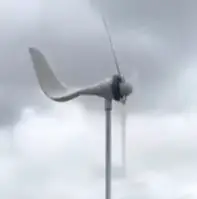
Overall, the Windmill 1500W is more expensive than other models on the market, but it makes up for it in value. The built-in charge controller, high energy output, and relatively lightweight design are all money-saving opportunities for homeowners who are new to the wind turbine scene.
The 3-blade turbines are high-quality glass fiber with UV protection coating. It’s designed to operate at full capacity with 31 mph wind speeds and, according to the manufacturer, it withstands a level 3 category hurricane.
The cut-in wind speed is 5.6 mph, meaning this turbine is best for moderately windy areas. If the turbine encounters high wind gusts or surges, the automatic braking system can quickly correct and prevent overcharging of the battery.
The 24V system has a suggested battery capacity of 200A or higher and is capable of powering small, off-the-grid home systems.
While the 1500W energy output isn’t designed to meet an entire household’s consumption needs, it can easily be paired with a solar array. This offers great flexibility for homeowners looking to go completely green and reduce their reliance on city grids.
The turbine’s generator also comes equipped with a built-in MPPT charge controller. The integrated system doesn’t require extra bells and whistles and is completely stand-alone, minus the battery. Should any parts malfunction, this manufacturer offers a one-year warranty.
Our Experience
Prior to getting this wind turbine, we didn’t think we would rank it as our top choice because we read some pretty disappointing reviews from previous customers.
After we tested it, our first impression was that it didn’t make much noise. This widens your opportunities to install it (space-wise) since it’s not an annoyance for your household or neighbors.
In terms of performance, we mounted it on a rooftop as the manufacturer recommends having it 22 feet or 7 meters above ground for it to function properly. On a windy day, it performed as expected with a 24V battery.
One thing we did notice was that there wasn’t enough information of what exactly you will receive. Since we’re always testing these kinds of things, we keep tools and materials like wires ready for action. We used three 6 AWG (6 gauge) wires. The length of these depends on where you’ll mount the wind turbine.
If you’re new to the wind turbine world, you’ll definitely receive a good quality product, but your initial investment will go further than the price of the wind turbine since you’ll need to purchase other materials on the side like wires and mounting brackets to put this in place.
See Price on Amazon2. Best Budget Pick: Windmill (DB-400) 400W 12V Wind Turbine Generator kit
Product Ratings
| Reliability: | 3.5/5 |
| Sturdiness: | 5/5 |
| Quality vs Price: | 4/5 |
Blades: 3 | Wind Speed Rating: 28 mph | Minimum Wind Speed: 6.7 mph | Volts: 12V | Weight: 16.8 pounds | Dimensions: 31.5 x 12.3 x 13.6 inches | Charge Controller Included: Yes
What We Liked
- Wide range of sizes
- Easy to fit and remove
- Rugged build and decent lifespan
What We Didn’t Like
- Some issues with latch reported
Description
This little wind turbine includes almost all the perks from the previous wind turbine.
It’s a sturdy choice built for both marine and land places with protection against saltwater corrosion, UV protection coating, sudden voltage surge, and wind gust. Its integrated automatic braking system and manual braking switch come in handy for any situation and avoid overcharging your battery.

It’s easy to install and can be connected to an existing solar panel system. With the MPPT charge controller built-in at the back of the turbine, this option was built to take on minimal space and save some bucks.
With its capacity of 400 Watts, you can charge small appliances like blenders, phones, laptops, or cameras whether you’re at home or in a remote cabin.
Our Experience
Overall, our experience with this wind turbine was great, the only complaint we would have is that the manufacturers claim it works from a wind speed of 6.7 mph when it actually took us 12 or 13 mph to get it going. We placed it on a rooftop close to our solar panels, so we don’t know how it would work on a pallet on a lake or similar.
If you’re thinking about installing it close or on top of the water, our best recommendation is to wait for the wind turbine to arrive and then go to a hardware store to buy all the necessary materials you’ll need to make a durable and functional installation.
Other than that, it’s the perfect companion for our solar panels. It should last for a good number of years thanks to the quality materials and build.
This could be the perfect option for someone that isn’t looking to power an entire household, looking for something more affordable than the other options, and for those who want to use a wind turbine up in the mountains, close to the beach, or somewhere with high wind speeds.
See Price on Amazon3. Best Mid-Range Option: PIKASOLA 1000W
Product Ratings
| Reliability: | 4.5/5 |
| Sturdiness: | 4/5 |
| Quality vs Price: | 5/5 |
Blades: 3 | Wind Speed Rating: 56 mph | Minimum Wind Speed: 6 mph | Volts: 24 V | Weight: 55 pounds | Dimensions: 52 x 16 x 12 inches | Charge Controller Included: Yes
What We Liked
- Comes with a lot of perks that make it highly efficient
- Low minimum wind speed
- A lot of useful information from Pikasola about the product and how to install it
- According to other users, the customer service is excellent
What We Didn’t Like
- It comes with very short wires. Installation can be a bit tricky
- It’s pretty heavy
- Shipping time could be from 7 to 15 days
Description
This wind turbine is made with lightweight nylon material which makes it waterproof, corrosion-resistant, and highly efficient. It comes with three 46.8-inch long blades made of nylon carbon fiber.
Its generator is a three-phase permanent magnet synchronous motor and has a fully integrated voltage regulator that automatically shuts down when the battery is fully charged. The fan is controlled by an MPPT intelligent microprocessor.
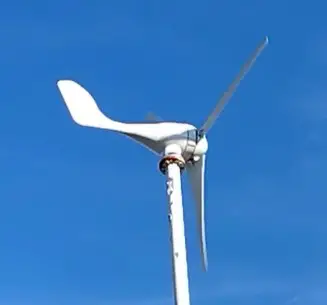
The price includes all the standard pieces for an easy installation of your wind turbine including a set of screws and nuts. As per usual, you’ll need to purchase your own battery and mounting pole, but this time you won’t need to wait until your wind turbine arrives since the manufacturers include a recommendation in their description.
Pikasola recommends using steel pipes or iron pipes with a diameter of 70±2mm.
Our Experience
Even though we couldn’t find many reviews from this particular product from Pikasola, it was like a breath of fresh air in terms of getting information before clicking on the “add to cart” button. With many of the wind turbines we researched, the amount of information from the manufacturers is very limited.
In terms of testing this wind turbine, we can say that it’s not made with the kind of sturdy materials as the two Windmaxx options, but it’s still a great choice if you’re looking for something a little less expensive and that’s built to last.
The thing that did slightly concern us is that, even though this is our mid-range option, the 4” wires at the bottom are really short. We had to cut the tubes around the wires to add more wire and seal them properly to avoid a potential fire hazard.
Also, for a home wind turbine, it’s a bit heavy. We conducted all of our tests on a concrete rooftop, so we didn’t have any trouble, but if that’s not your case, we highly recommend looking for another location, like hard ground away from trees or other things that can steal some wind from your turbine.
The manufacturers recommend placing it at least 20 ft high.
See Price on Amazon4. Best Home Wind Turbine for Wet Areas: 2000-Watt Marine Wind Turbine Power Generator
Product Ratings
| Reliability: | 4.5/5 |
| Sturdiness: | 5/5 |
| Quality vs Price: | 4.5/5 |
Blades: 3 | Wind Speed Rating: 28 mph | Minimum Wind Speed: 7 mph | Volts: 12 V | Weight: 38 pounds | Dimensions: 34.5 x 18.5 x 13.5 inches | Charge Controller Included: Yes
What We Liked
- Wide range of sizes
- Easy to fit and remove
- Rugged build and decent lifespan
What We Didn’t Like
- Some issues with latch reported
Description
The key selling point for this home wind turbine is that it can be installed on land or in a body of water, like a lake, pond, or on the beach. With a marine-proof coating, the turbine is able to withstand harsh weather and water splashes, unlike other models. If you live in a coastal area or have a cabin near the lake, then this turbine is ideal.
The Marine Wind Turbine can also produce up to 2000W with winds at 28 mph. The wind cut-in speed is 7 mph according to the manufacturers, which is fairly high for the industry. Ultimately, the turbine isn’t well-suited for non-windy areas and should only be used by homeowners who live in areas with high wind speeds.

The body is made of durable cast aluminum and can withstand winds of up to 110 mph, making it effectively weather-proof. The kit doesn’t come with the necessary metal pole for installation, which is standard, so a 1.5-inch steel pipe should be purchased, as well. Overall, installation is fairly easy as there are only 5 parts needed for assembly.
The turbine comes with a 3-phase synchronous generator that can be used to charge a 12V battery. This is enough power to run small devices, such as laptops, tools, lights, or phones.
If you’d like to power an entire household, then a minimum of 3 turbines should be used. They can be tied together, like solar panels, as long as they’re placed roughly 58 feet apart.
Our Experience
Our first impression was that this is an effective, sturdy, and modern-looking wind turbine. With 3 carbon fiber blades, the Marine Wind Turbine is able to harvest enough energy to power small devices and home appliances when connecting it to a 12 V battery without making a sound.
The turbine came equipped with all the standard essentials, plus a few extra features, like Overspeed protection. We loved the fact that we could place the turbine wherever we wanted to, even in open bodies of water, without any worry. This is something you can’t do with other wind turbines.
It also comes with a one-year limited warranty which gave us a little peace of mind after deciding to make the investment.
Even though this was a great purchase, we’re still partially conflicted. While it’s not industrial wind-farm grade, the turbine does the job and performs well. This is essential for those who are solely reliant on wind power for electricity in off-the-grid situations.
But, we can’t confirm what the manufacturer claims about this wind turbine is suitable for 7 mph wind speeds as it didn’t work for us.
See Price on Amazon5. Best Wind Turbine and Solar Panel Kit for Home: ECO-WORTHY 600W Solar Wind Power Kit
Product Ratings
| Reliability: | 4/5 |
| Sturdiness: | 4/5 |
| Quality vs Price: | 5/5 |
Blades: 3 | Wind Speed Rating: 23.5 mph | Minimum Wind Speed: 5.6 mph | Volts: DC 12V/24V | Weight: 29.2 Lbs | Dimensions: 58.3 x 26.3 x 1.4 inches | Charge Controller Included: Yes
What We Liked
- Wide range of sizes
- Easy to fit and remove
- Rugged build and decent lifespan
What We Didn’t Like
- Some issues with latch reported
Product Description
With a wind turbine and a solar panel, you can rest assured that you won’t run out of energy. Eco-worthy is a well-known reliable alternative energy manufacturer.
The solar panel is 195 W monocrystalline, which is the best option when it comes to solar panels. It has a corrosion-resistant aluminum frame which makes it durable, reliable, and suitable for all surfaces.
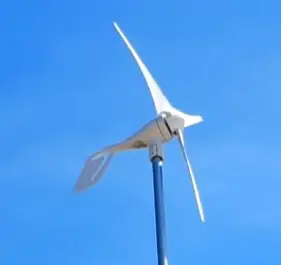
Meanwhile, the 400W wind turbine solves any sun rays shortage. It has a low start-up speed of 5.6 mph, high wind power utilization, is lightweight, and it has an auto windward direction adjustment.
The solar wind power kit includes a 20A PWM Hybrid Controller for battery protection. It can automatically shut down when the battery is fully charged, protecting it from overcharge and short circuits.
Our Experience
Overall we got a good quality product. We already know Eco-worthy solar panels, so we knew that this 195w wasn’t going to disappoint, and it didn’t. Now, in terms of the wind turbine, we had a hard time tracking its performance at first but it was during days when we didn’t have much wind. After a week, the blades got going and didn’t do bad.
Our best way to describe this would be for emergencies. It’s a true fact that if the blades of your turbine aren’t spinning you’ll have power from your solar panel, the thing is that separately, they’ll likely only generate enough energy to cover a few appliances or lighting.
See Price on AmazonThe Complete Wind Turbines for Home Buyer’s Guide
Getting a new wind turbine for home is certainly an investment. Top-tier models can easily cost you $1,000 or more, which is why it’s important for you to first consider a few key factors before making your choice.
Whether you’re planning on using your wind turbine to power barn lights or an underground bunker, there are different models that will suit your needs. From cheap, low-wattage units to marine-grade kits, there’s something for everyone.
How Windy is Your Area?
This is the most important consideration you’ll make when deciding on a turbine for your home. If you receive very low wind speeds, live in a densely populated area, or frequently experience gale-force winds, then a wind turbine probably isn’t the best option.
On average, home wind turbines need a minimum amount of wind in order to operate. This varies based on the model, but most clock in at around 6-7 mph.
The rated wind speeds for full energy production are generally around 27 mph for standard units. If you live in an area that experiences a steady amount of wind, then a normal residential turbine is fine. However, if you encounter regularly low wind speeds, you’ll need to look for models that have a lower threshold.
One of the biggest contributing factors is the blades. Those with more blades, like 9 to 11, have more surface area, weight, and torque to keep the rotor spinning. This means they’ll still be able to operate in low-wind conditions while 3-blade models cannot.
When purchasing a home wind turbine, keep your eye out for these product specifications:
- Starting wind speed
- Cut-in speed
- Rated wind speed
- Safe wind speed
What’s Your Average Energy Consumption?
The average American household with modern appliances uses around 8000-9400kWh of electricity per year.
If you’re looking to go completely off-grid, then you’ll need to meet a minimum threshold of 5 kW to 15 kW of power output. Most home wind turbines don’t come close to meeting this minimum, so they’ll need to be used in conjunction with other turbines or a different power source.
If you’re just looking to power small devices, like the pump of an outdoor pond, then a small, mid-wattage turbine is adequate. Those with 400-1000W of power can charge small appliances like laptops, phones, lights, power tools, and more. If you’re looking to use a turbine in combination with an inverter for an RV, you’ll probably need more.
Where Are You Planning on Installing Your Wind Turbine?
Wind turbines are designed to be placed high up in the air. The turbine and generator must be mounted on a tall pole that’s around 25-60 ft in height. However, turbines aren’t only limited to large fields or hilltops. Home wind turbines can also be placed on a roof (like in your rooftop garden) or in a body of water.
Depending on the amount of square footage you have available to you, there are a variety of options. For those living in more compact environments, a turbine that has a small rotor radius is essential. On the other hand, if you’re looking to mount your turbine on the roof, then you’ll need a model that isn’t heavy and cumbersome.
Be aware that each turbine needs to be placed within a buffer zone. Two turbines should never be placed right next to each other. An easy way to figure out the right distance for placement is to multiply the turbine’s blade radius by 10. This will give you a general estimate, although consulting the manufacturer is the preferred choice.
Will You Pair Your Wind Turbine With an Alternative Power Source?
Wind turbines work great when paired with a solar array as it maximizes your capacity to produce energy. During the day, the solar panels can soak up the sun’s rays, while your wind turbine can generate power with evening gusts of wind.
If you’re looking to go completely off-grid, then this pairing is the most reliable choice as you can’t always guarantee that you’re going to get enough wind each day.
On the other hand, if you want to commit to purely wind energy, then you’ll need to look for high-wattage kits. 100-1000W won’t produce nearly enough energy and will simply waste your time, money, and energy. Those with more than 3 blades and a 2000W energy output are much better suited for cabin dwellers and off-grid systems.
Frequently Asked Questions (FAQ)
Q: How Do Wind Turbines Work?
A: The basic operation of a wind turbine is actually fairly simple: the wind turns the blades of a turbine around a rotor, which then spins the generator to create electricity that an external battery bank stores.
Overall, you must place wind turbines in an area that receives a minimum amount of wind according to the manufacturer. For an average home wind turbine, that’s usually a wind speed of 5.5 mph or more. Without this minimum amount of wind, the blades just won’t spin, and no electricity will be produced.
However, the rated energy output of a turbine can’t be achieved unless the turbine has access to its rated wind speed, which is the average amount of wind needed to get the generator producing at max capacity. For example, a 500W turbine rated for 27 mph wind speeds will only generate around 100W of power when the wind is 10-12 mph.
Q: What’s the Average Power Output of a Wind Turbine?
A: Most home wind turbines advertise between 100W and 2000W of power. However, the actual amount of wattage is dependent on the wind speed and efficiency of the generator. While some models have high power ratings, they may only perform at very high wind speeds that most homeowners may not have access to.
Most homeowners aren’t looking to set up a mini wind farm on their property, however, a network of turbines and solar panels is the way to go if you’re planning on being entirely off-grid.
Q: Can a Wind Turbine Withstand Inclement Weather?
A: Depending on the model you purchase, wind turbines have a surprising ability to withstand heavy gales, storms, and wind surges. Generally, home wind turbines can manage wind speeds of up to 90-100 mph before they begin to break or malfunction.
You should read carefully the manufacturer’s descriptions as some mid-rage turbines are coated with anti-corrosive materials for coastal regions or small bodies of water in rural areas.
Q: How Much Money Will a Wind Turbine Save Me Per Month?
A: The amount of money you’ll save by using a wind turbine is entirely dependent on your average household electricity consumption and the standard price for electricity in your area. On average, an American household will use around 780 kWh per month.
